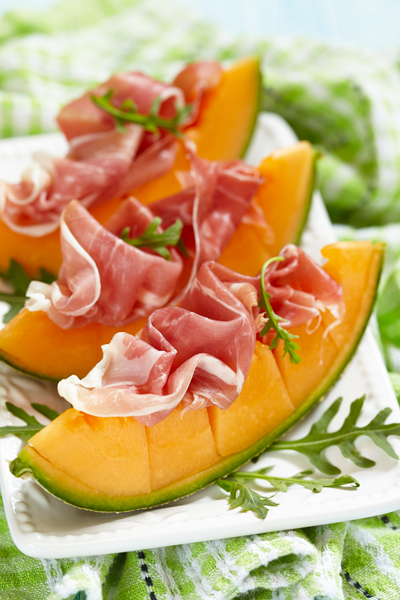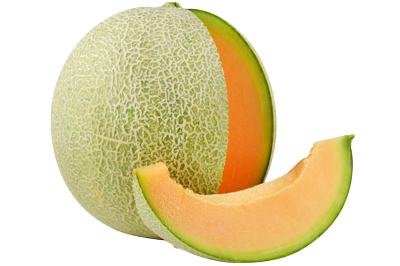Health
benefits
Sweet flavor, few calories!
Melons are very sweet but low in calories. Is that a paradox? No! Melons are not very tart, meaning that, happily, their natural sweet flavor is the one that stands out. Have as much as you want!
They also contain potassium
Melons are also:
- a source of vitamin B9 (for cellular renewal, particularly important for pregnant women for fetal development, for growing children, and for convalescents).
- a source of vitamin C (for immune and nervous system health, collagen formation, energy, fatigue reduction, and iron absorption)
- a source of provitamin A or beta-carotene (for iron metabolism, skin and mucous membrane health, vision, immune system health, and growth)
Nutritional
composition

When is the right
time to eat them?
Summer.
Melons are in the gourd family (like zucchini, peppers, cucumbers, and more) and are therefore a summer crop. Their high season extends from June to September.
-
January
-
February
-
March
-
April
-
May
-
June
-
July
-
August
-
September
-
October
-
November
-
December
Vegetable patch or
urban balcony?
Melons are annuals that grow well in full sun, in deep, well-drained soil rich in humus.
To learn everything you need to know about growing melons, read the page on growing advice.
Choosing and
storing melons
Choose your melons well:
- Appearances can be deceiving; the weight is what counts. Melons should be heavy and dense.
- A fresh melon gives off a fragrant smell, without an odor of ether.
- Look at the stem as well; it will come off when the fruit is mature.
- Ask for a taste at the farmer’s market!
Properly store your melons:
- Your melon isn’t ripe? Leave it out at room temperature for two to three days.
- In the refrigerator: Keep it two to three days in the vegetable drawer, in a plastic bag so that its flavor does not seep into other foods.
- In the freezer: Cut it into cubes and seal them in a freezer bag.
Tips and
tricks
How to prepare a melon
Cut it in two and remove the seeds with a spoon. Cut it into slices and remove the skin, then eat it raw right away! You can also cut it into cubes or use a melon baller to make spheres.
Cooking times::
- A few minutes: on the grill
- 5 min: sautéed in a pan or a wok
- 15 min: steamed in a saucepan
- 45 min: for jam
Melons go well with…
Raw: Melons go very well with highly salty foods such as Bayonne ham or Bündnerfleisch, the air-dried Swiss meat, and some cheeses like feta and mozzarella. They also pair well with fresh mint, which accentuates their refreshing side.
In salads, mix melons with cucumbers, lettuce, lamb’s lettuce, cherry tomatoes, and more. Melon kabobs are a delicious appetizer.
In sweet preparations, for example fruit salads, melon pieces are delicious with all summer fruits (plums, grapes, peaches, apricots, etc.). Melon sorbets provide wonderful refreshment!
Cooked: Lightly sautéed or grilled, melons are a subtle side dish for fish or grilled meat.
Italians like melons served with salty ham. In the Balkans, people love the combination of the sweet taste of melons with salty cheese like feta and mint, sweet red onions, and salty olives. Meanwhile, other Eastern Europeans prefer pickled melon, melon jam, and cold melon soup.
Can everyone
eat them?

Young children
Starting at 12 months of age, children can enjoy and be refreshed by flavorful, sweet melons. For older children, melons go well in dairy products or in mousses.
And everyone else
People with sensitive bowels should be wary. Melons stimulate bowel movements because of their combination of water, fiber, and potassium.
Furthermore, it is not recommended to drink water immediately after eating melon, as the two together may speed up bowel movements!
Some people may also be allergic to melons. This is especially the case for some cross-allergies with nuts, apples, or pollen (hay fever).
See plenty of other tips for encouraging children to eat vegetables
Where do they come from?
Origins and varieties
Origins: China is responsible for almost 50% of world melon production, followed by Turkey and Iran, then the United States and Kazakhstan. Spain is the top European producer, followed by Italy, France, Ukraine, and Greece. In the off-season, melons mainly come from Brazil.
Varieties: There are over 650 melon varieties: musk melons (orange flesh and woody skin), cantaloupes (orange flesh and smooth skin), Galia melons (green skin, orangey-brown skin), canary melons, honeydew melons, Ogen melons, Santa Claus melons, and more.


